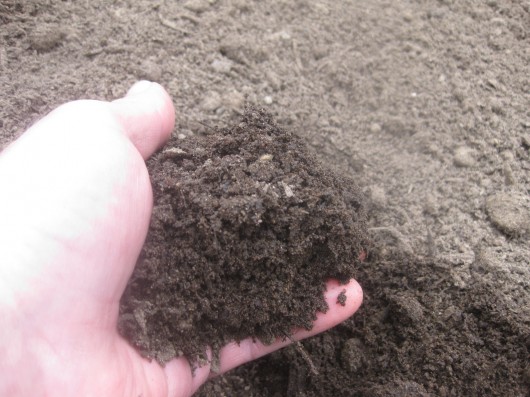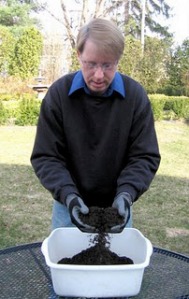Last updated on May 7th, 2012
 THE ART OF SOIL-MAKING can be surprisingly simple or unnecessarily complicated. I prefer the easy approach. After all, most potted plants are hardy enough to thrive in any formula that holds moisture (but not too much) and contains gritty matter for drainage and root-aeration. My own plants prosper in various adaptations of this old-fashioned, but tried-and-true mixture:
THE ART OF SOIL-MAKING can be surprisingly simple or unnecessarily complicated. I prefer the easy approach. After all, most potted plants are hardy enough to thrive in any formula that holds moisture (but not too much) and contains gritty matter for drainage and root-aeration. My own plants prosper in various adaptations of this old-fashioned, but tried-and-true mixture:
-
One part well-worked garden soil
-
One part leaf mold (or compost)
-
One part sand

My nifty soil-sifter
Next, the sifted soil is poured into a roasting pan, sprinkled lightly with water, covered with a lid and baked for exactly one hour in a 180-degree oven. The goal is not to sterilize the soil, which would render it inert, but only to pastuerize it. Thus, nutrients are preserved, while weed seeds, insects and harmful pathogens are eliminated. Contrary to what you may have heard, soil does not emit an unpleasant odor as it bakes.
Leaf Mold – This is the soft, crumbly substance that results after autumn leaves are saved in a pile, moistened regularly, and allowed to decay for at least two years. The best leaf mold for houseplants is always found at the bottom of the pile. This, too, must be sifted and pasteurized in the same manner as for garden soil. I can’t imagine gardening without leaf mold. It is far superior to peat moss in terms of both nutritional value and moisture-retention.
Compost – If you have a compost heap, you can use this rich, nutritious material for your houseplants. Gather some of the most decayed produce from your pile, then sift and bake it.
Sand – This is the gritty matter that lightens and introduces pockets of air to the potting mix. I use coarse builder’s sand, not seashore or playbox sand. Builder’s sand is available at most hardware and building-supply outfits, but only in enormous quantities. If you don’t wish to have a heavy sack of sand in your house, you can always substitute perlite. Perlite is a volcanic mineral that forms porous white granules when exposed to high heat. You can buy it in small quantities at almost any garden center.
I like to keep my soil components in separate, air-tight containers. Then, when soil is required, I can withdraw the approximate quantities I need and blend them by hand in a large bowl or dishpan.

Black gold!
It is wise to vary the basic soil mixture for certain plants. African violets and ferns, for instance, prefer a light, woodsy formula. For them, I increase the amount of leaf mold and reduce the sand. Azaleas and citrus plants like an acidic soil, so I add to the basic mix either a handful of composted oak leaves, or humus gathered from beneath my arborvitae hedge. I give my geraniums and herbs soil, leaf mold and sand in equal parts.
Learning to make potting soil is no different from learning to cook without a recipe. One has to experiment with the ingredients and adjust their proportions until the concoction seems “just right.” Remember that most plants aren’t overly fussy about soil. If your mixture holds moisture and drains well, you’ve essentially hit the jack-pot.
Houseplants do not require a diet of expensive, peat moss-based potting formula anymore than a child requires a diet of cheez-whiz. When we make our own potting soil from sustainable substances, our planet, plants and purses all benefit. Won’t you give this soil-making venture a try?
Don’t miss anything at A Garden for the House…sign up for Kevin’s weekly newsletter.
Related Posts:
The Easy Kitchen Garden
The Window Garden in February
Can You Help the Honey Bees?

istanbuldailyphoto says
Yes, a pleasant thing as can not be involved with the garden. Good work.
Kevin Lee Jacobs says
Welcome to A Garden In The House, istanbuldaily!
draymond says
Hello again. This is a very interesting idea. I’ve always used peat because that was the way it was done. I’ll have to try this on some of my plants to see if there’s a difference.
Anonymous says
Hi Kevin
First of all, I love this blog! The photos are great and you write so well. I am not doing much gardening right now but might get inspired to do so based on what I have read here so far.
Jed
Kevin Lee Jacobs says
Welcome, Jed! I hope you will stop by often!
Charlie benedick says
I recently became a Master Gardener and believed I was better than average in the garden knowledge department… U til I subscribed to your newsletter! You are fantastic!!! I have a west facing sidewalk with too far spaced apart boxwoods. It will take forever for them to grow tight enough for a hedge. Can you give me more detail on boxwood cuttings for a large area? Thank you! You are marvelous I’m so glad I found you!!
Hildegard says
I leave a response each time I appreciate a post on a site
or I have something to add to the conversation. Usually it is
a result of the fire communicated in the post I looked at.
And after this post How To Make Your Own Potting Soil. I was actually excited enough to
drop a comment 😉 I actually do have 2 questions for you if it’s okay. Is it simply me or do a few of these responses appear like coming from brain dead folks? 😛 And, if you are writing at other online social sites, I would like to follow you. Would you make a list the complete urls of all your shared pages like your twitter feed, Facebook page or linkedin profile?
Lee McCann says
I think it’s wonderful that others acknowledge to you how you inspire them. It’s lovely when
a fire has been lit and someone does something about changing themselves or their environment. You are my inspiration. I have even started to cook a little. Tonight is
pan-seared salmon with olive oil and fresh lemon. Lee
Joanna says
I wonder if you know about Azomite – looks like this mineral has a great reviews. http://www.amazon.com/Lbs-Azomite-Additive-Fertilizer-Minerals/product-reviews/B000E7MTT4/ref=dpx_acr_rat_t2_txt?showViewpoints=1
Gale says
Thanks for a wonderful lesson in soil building.
By any chance would you write about how to grow citrus?
And is there any chance they can be grown from seed?
Thanks for a great blog, on so many subjects.
Kevin Lee Jacobs says
Hi Gale – I live in a cold climate (New York’s Hudson Valley), so no citrus trees on my property. I have, however, successfully grown Meyer Lemon as a houseplant. It bloomed and fruited fabulously for about 5 years. For details, type “Meyer Lemon” into the search box at the top of this page. All best – KLJ